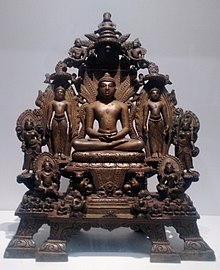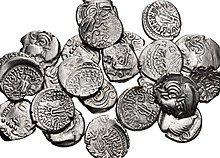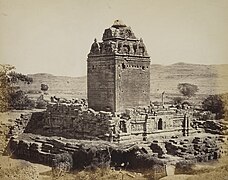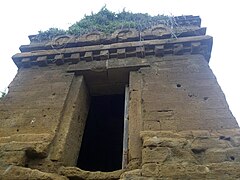Temples and monuments
- Mentioned in the literary sources
The copper plate inscriptions of Maitrakas mentions religious edifices, Brahmanical as well as Buddhist. Some Buddhist monuments were constructed by the Maitrakas themselves. Some Brahmanical shrines includes Shiva temple at Vatapadra in Saurashtra (before 609 CE), Bhartishwara temple (extant in 631 CE), Goddess Kotammahika temple at Trisangamaka (extant in 639 CE, built during or before reign of Droṇasiṁha), Pandurarya temple at Hathab in Saurashtra (502 CE inscription). Other temples include Saptamatrika temple at Madasara-sthali (extant in 676 CE), Sun temple at Vatapadra (609 CE) and Bhadreniyaka (611 CE); all in Saurashtra. [27]
Several Buddhist monuments were built by Maitrakas. Majority of them were built in and around Vallabhi. Bhataraka probably the Bhataraka-vihara. Princess Dudda, sister of Dhruvasena I, built Dudda-vihara around the onset of the sixth century. Before 605 CE, Śilāditya I built Śilāditya-vihara Vamsakata in Saurashtra. Abhyantarika-vihara (before 567 CE) was built by a lady Mimma. Kakka Mankila added Kakka-vihara to Dudda-vihara mandala before 589 CE and another Gohaka-vihara was built there before 629 CE. The Yakshasura-vihara for nuns at Vallabhi was built around middle of the sixth century. Before 549 CE, Ajita, a merchant, built Ajita-vihara, probably besides the Yakshasura-vihara. Purnabhatta-vihara was built by Purnabhatta before 638 CE to the later group. Skandabhatta II, grandson of Mahasandhivigrahaka Sandabhatta I, built a Sandabhatta-vihara at Yodhavaka. [27]
Literary sources also mention some temples dedicated to the Jinas. Around 601 CE, Shantinatha temple at Vallabhi existed. At the time of destruction of Vallabhi, the images of Chandraprabha, Adinatha, Parshwanatha and Mahavira were transferred to safer places. The temples of Parshwanatha and Shantinatha existed at Vardhamana (Wadhwan) and Dostatika as well as probably the temple of Yakshi Ambika on the summit of Mount Girnar. [27]
Most of the constructions in this period were made of non-durable materials like bricks and wood. None of them survives now. [27]
- Extant temples
The architecture is in continuum of earlier Gupta period architecture found in caves at Uparkot and Khambhalida. More than hundred temples of this period is known. Almost all of them are located along the coastal belt of the western Saurashtra region except the one at Kalsar and few temples in the Barda hills region. Several temples of them are located in the territories controlled by the Saindhavas. [27]
The extant temples of this period are the temple at Gop, Sonkansari (Ghumli), Pachtar, Prachi, Firangi Deval at Kalsar, group of temples at Vasai near Dwarka, Kadvar, Bileshwar, Sutrapada, Visavada, Kinderkheda, Pata, Miyani, Pindara, Khimrana, two temples at Dhrasanvel (Magderu and Kalika Temple), two temples near Dhrewad (Kalika Mata Temple), Gayatri temple and Naga temple and Sun temple at Pasnavada, early temples at Junagadh, Gosa, Boricha, Prabhas Patan, Savri, Navadra, Suvarnatirth temple at Dwarka, Jhamra, Degam near Porbandar, Sarma near Ghed. Other extant temples include the temple groups at Khimeshwara, Shrinagar, Nandeshwara, Balej, Bhansara, Odadar; and the shrines at Bokhira, Chhaya, Visavada, Kuchadi, Ranavav, Tukada, Akhodar, Kalavad, Bhanvad, Pasthar, and Porbandar. [27]
Two kund s are known of this period, at Kadvar and Bhansara. The Shaivaite monastery at the Khimeshwara group of temples is the oldest known Brahminical monastery of India, preceding three centuries to that in central India. [27]
These temples are austere in their design and simple in decoration. They are important in architectural study to know the origin of Nagara-style shikhara and the beginning of their complex designs in temple architecture. These temples also point to the second of the two early Gujarat temple architecture schools; the north Gujarat early Nagara style and the Saurashtra style which initially influenced and ultimately ousted by the evolving Nagara style. The Saurashtra style disappeared by the tenth century. [27]

























